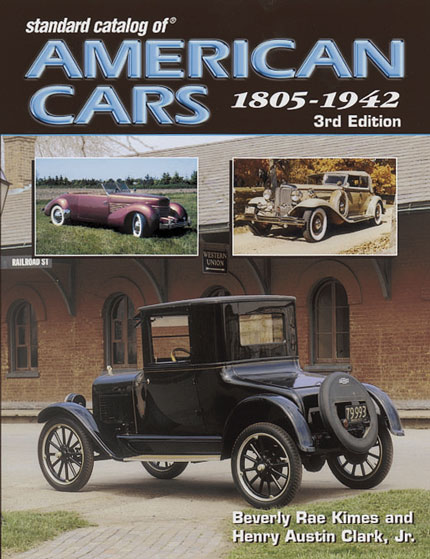If you don’t own the Standard Catalog of American Cars, get one. Now.
The very first of the 5000-plus alphabetical entries in the hefty Standard Catalog of American Cars, 1805–1942 is the company Abbott-Akin. It reads like many of the book’s entries: “Early in 1914, in Johnsonville, New York, the Abbott-Akin Company was incorporated with a capital stock of $10,000 for the manufacture and sale of automobiles. The incorporators were Ernest H. Abbott, John Slade, and Howard V. Akin, all of Johnsonville. No Abbott-Akin automobile is believed to have followed.”
If you don’t have at least one of the various iterations of the Standard Catalog on your shelf, your library is missing a major reference point as well as a decent door stop and fly squasher. The 1805–1942 volume is a triumph of historical research from a team of meticulous obsessives, and it’s also a delightful read (in places). As the so-called First Lady of Automotive History, lead author Beverly Rae Kimes wrote in the intro, “The history of the American automobile is a can of worms that would make any self-respecting bilateral invertebrate blanche [sic].”
Anyone who bought shares in Pets.com can attest that the early days of a burgeoning industry are full of dreamers and get-rich-quick schemers. Open the book to almost any of its 1536 pages, and there is an interesting story. Often it’s about a backyard tinkerer hoping to become the next Henry Ford, such as Michael de Cosmo, who created the first and only Delia Amphibian, nicknamed the Motor Duck. He stunned beachgoers in 1916 when he suddenly drove into the surf near San Francisco, making 10 mph through the waves before being swamped.
Indiana pulley maker Milton Reeves’s first vehicle, the 1896 Motocycle, so frightened the horses that he made two key modifications: likely the world’s first automobile muffler, and a giant horse head to go on the nose. A decade after that failure, Reeves created the $3200 21-foot-long, eight-wheeled Octoauto, which he displayed at the inaugural Indy 500 in 1911, and followed that up with the somehow more expensive (at $5000) Sextoauto. Both flopped.
About a century ahead of Amazon, one John H. Bush of Chicago decided to go into the mail-order car business. In June 1915, he started sending out brochures for the Bush motorcar that requested payment in advance. When an order came in, Bush went to whatever car company had an available unit on the end of its assembly line, bought it wholesale, stuck a Bush nameplate on the radiator, and sent it off to the buyer. Bush eventually went bust when no legit company would sell him a car.
In 1875, the Wisconsin legislature appropriated $10,000 for a prize to go to the first citizen of the state who developed a “cheap and practical substitute for use of horses and other animals on the highway and farm.” A certain E.P. Cowles of Wequiock thought he had the answer with his 14,255-pound Green Bay, a steam-powered goliath that towed its own tender loaded with coal and water. Only two cars showed up on July 16, 1878, for the 200-mile race that was to determine the winner, and Cowles lost valuable time when he became the first driver ever to crash in a car race in the United States, veering into a culvert early on. The winner, the two-cylinder Oshkosh, a veritable Lotus Super 7 of steam cars at only 10,000 pounds, covered the distance in 33 hours and 27 minutes, averaging just over 6 mph.
The beer barons at Anheuser-Busch rode out Prohibition making truck and bus bodies and also launched the Bevo Boat, a nautically-themed car intended to promote a non-alcoholic brew called Bevo. The 1910 Only Torpedo promised 60 mph and 30 mpg from a one-cylinder engine displacing 201 cubic inches. The one and only 1910 Mahana was advertised as being able to “plow, harrow, mow, haul loads of three tons, carry the family to the county fair, and do other useful things,” all for less than $1000.
The book’s final entry, the 1914 Zip, was a 16-hp one-off built by a backyard grease monkey in Columbus, Texas, who welded the axles directly to the frame. Says the book, it “must have been a bumpy ride.” And indeed, it has been.



I am having a hard time researching an inherited 1930 Ford 3d turnabout. Totally restored. I have title. Can not look up by year and make or vin anywhere. Any suggestions?